Solar-friendly pasta dishes offer delicious and sustainable cooking options for your Mediterranean-inspired meals. You'll love trying the easy sun-dried tomato pasta, which combines creamy textures with rich flavors, or the fresh summer garden fusilli that features sun-marinated tomatoes and herbs. The solar-cooked creamy pesto linguine makes an excellent choice for basil lovers, while Mediterranean solar box noodles provide a lighter, zucchini-based alternative. Don't forget to experiment with quick solar pasta alfredo or herb-infused variations for added variety. These eco-conscious recipes are just the beginning of your solar cooking journey.
Easy Sun-Dried Tomato Pasta
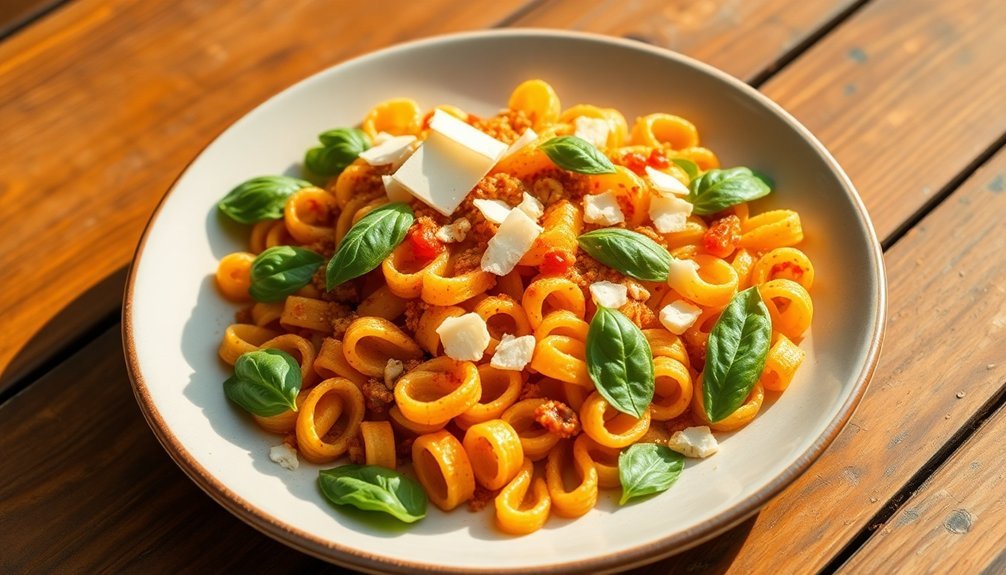
This vibrant sun-dried tomato pasta combines rich Mediterranean flavors with creamy textures for a satisfying meal you can prepare in under 30 minutes.
You'll start by cooking your choice of pasta, whether it's penne or lumaconi, in salted water until it reaches al dente perfection. Don't forget to reserve some pasta water for adjusting the sauce later.
While the pasta cooks, you'll create a luxurious sauce by sautéing chopped sun-dried tomatoes in their oil for a couple of minutes.
Add butter and flour to form a golden base, then incorporate your choice of dairy – heavy cream, half-and-half, or milk. The creamy sauce packs about 437 calories per serving.
Season the sauce with minced garlic, Italian herbs, and a pinch of red pepper flakes for heat.
To achieve the perfect creamy consistency, stir in freshly grated parmesan and mozzarella until melted.
You can customize your dish by adding protein like chicken or shrimp, or keep it vegetarian with fresh spinach.
If the sauce becomes too thick, simply thin it with the reserved pasta water.
Finish your creation with a garnish of fresh basil and extra parmesan, then serve immediately while it's hot and perfectly sauced.
Mediterranean Solar Box Noodles
You'll find Mediterranean Solar Box Noodles offer a perfect balance between traditional cooking and eco-friendly preparation, especially when you let tomatoes and garlic marinate in sunlight for 4-5 hours before combining them with your zucchini noodles.
For quick Mediterranean flavors, toss your spiralized zucchini with olive oil, sun-warmed garlic, and fresh basil, then top with feta or nutritional yeast.
While the sun naturally enhances your sauce ingredients, you can finish the dish with a quick 10-minute bake at 400°F or a brief sauté until the zucchini reaches the perfect al dente texture. This method provides a nutrient-rich meal containing 174 calories per serving while maintaining the authentic taste of Mediterranean cuisine.
Solar-Powered Cooking Tips
Ready to master solar-powered pasta cooking? You'll need an inclined window solar box cooker (SBC) designed for Mediterranean latitudes. Your SBC should be non-cardboard, weigh 8-10 kg, and match the size of a microwave oven. Position the window aperture perpendicular to the horizontal, guaranteeing it tracks the sun's movement.
For perfect pasta, combine your uncooked noodles, sauce, and extra water in a single pot – they'll cook simultaneously. You'll need enough water to guarantee the pasta becomes tender without turning mushy. A dish like Mediterranean zucchini noodles pairs wonderfully with kalamata olives for authentic flavor.
While traditional cooking takes less time, your solar-cooked pasta will need about 2 hours to reach internal temperatures of up to 190°C. Track your cooking progress using stainless-steel analogue dial temperature probes for accuracy.
Your SBC can achieve unloaded internal temperatures of 120°C at 192 W solar irradiance. To enhance flavor, add garlic powder, basil, black pepper, and chili powder.
You'll appreciate how solar cooking protects your food from wind-blown contaminants while preserving micronutrients and vitamins due to lower cooking temperatures. Plus, your solar cooker will keep food warm during off-sunshine hours, guaranteeing both safety and convenience.
Quick Mediterranean Flavor Hacks
After mastering the solar cooking basics, let's elevate your Mediterranean pasta dishes with simple flavor combinations. You'll find that Mediterranean ingredients work beautifully in solar cooking, as their robust flavors intensify under gentle heat.
Start with your choice of pasta – whether it's traditional fettuccine or gluten-free alternatives – and build your flavors from there.
- Create your base by sautéing garlic and red pepper flakes in olive oil, then add cherry tomatoes and zucchini. These vegetables release their natural sweetness during solar cooking, creating a perfect foundation for your dish.
- Layer in marinated elements like artichoke hearts and Kalamata olives, which add instant depth without extra cooking time. You'll want to incorporate these towards the end to maintain their distinct flavors.
- Finish with fresh herbs and your choice of cheese. Basil, parsley, and oregano brighten the dish, while feta or vegan parmesan add a satisfying salty note.
You can prep all ingredients in advance and store them separately, making solar cooking even more efficient.
Remember to reserve some pasta water – it's your secret weapon for creating a silky sauce that brings everything together perfectly.
Solar-Cooked Creamy Pesto Linguine
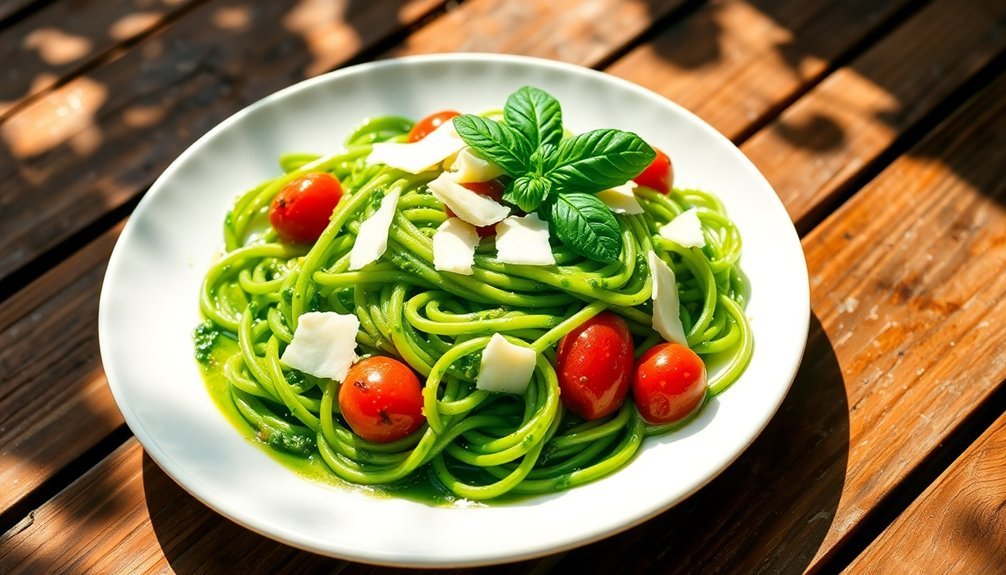
You'll need simple ingredients to create this sun-powered pesto linguine, including fresh basil, pine nuts, parmesan cheese, and your choice of cream or dairy-free alternatives.
To prepare the dish, you'll first combine basil, nuts, and garlic in a food processor while your pasta cooks in the solar oven.
Then mix your homemade pesto with a warming cream sauce. The entire dish comes together when you toss the solar-cooked pasta with your creamy pesto mixture, adding a splash of pasta water to achieve the perfect consistency.
Solar Pesto Recipe Steps
Creating an authentic solar-cooked creamy pesto linguine starts with properly preparing the pesto base. You'll want to begin with fresh, dry basil wrapped in paper towels to remove excess moisture. Add your chopped garlic, toasted pine nuts (or walnuts), and lemon juice to the food processor, blending until chunky.
While the processor runs on low, slowly drizzle in your olive oil to create the perfect consistency.
To transform your pesto into a creamy delight, you'll need to:
- Stir in finely grated parmesan cheese and your choice of heavy cream, butter, or cream cheese
- Whisk in light cream, tomato paste, and additional lemon juice for enhanced flavor
- Adjust the thickness with extra olive oil and season with salt and pepper
While your pasta cooks in salted water, sauté sun-dried tomatoes in your solar-heated stockpot.
Once your pasta's done, drain it and save some cooking water. Off the heat, combine your cream mixture with the pesto, then toss with your pasta. You can adjust the consistency using the reserved pasta water, and don't forget to garnish with extra parmesan and fresh herbs.
Sun-Dried Ingredients Needed
Essential sun-dried ingredients for your solar-cooked creamy pesto linguine include both star components and supporting elements.
You'll need sun-dried tomatoes packed in oil (about ½ cup) or 3-4 ounces of prepared sun-dried tomato pesto as your base. For the pasta, choose between 8-10 ounces of linguine, fettuccine, or penne – either fresh or dried varieties work well.
The creamy element comes from combining ½ to 1 cup of heavy cream or a mixture of half-and-half with 4 ounces of mascarpone cheese.
You'll want to add freshly grated Parmesan and shredded Mozzarella for extra richness. For seasoning, include minced garlic cloves, dried basil, Italian seasoning, and red pepper flakes to taste.
Don't forget to keep some pasta water for adjusting the sauce consistency. You can enhance the dish with protein options like chicken, shrimp, or Italian sausage.
If you're planning to thin the sauce, white wine or broth works perfectly. For garnishing, have fresh basil leaves and extra Parmesan on hand.
Consider adding spinach for extra nutrition and color.
[DIRECTIONS]:
One-Pot Solar Pasta Primavera
In the midst of busy weeknight dinner planning, One-Pot Solar Pasta Primavera stands out as a versatile and efficient meal that combines fresh vegetables with perfectly cooked pasta.
You'll need just a few key ingredients: halved spaghetti noodles, your choice of fresh vegetables, and 4½ cups of broth, along with seasonings and dairy additions for a creamy finish.
The beauty of this dish lies in its simplicity and customization options. Simply combine your pasta, veggies, and broth in a large pot, bring to a boil, and cook for 12-15 minutes until everything's tender.
Add cream and Parmesan cheese at the end for extra richness.
To make your One-Pot Solar Pasta Primavera experience even better, follow these time-saving tips:
- Prep your vegetables the night before to cut down on dinner rush chaos
- Adjust the liquid amount as needed while cooking to achieve perfect pasta texture
- Consider adding pre-cooked protein like roasted chicken or shrimp for a heartier meal
You'll love how this 20-30 minute meal delivers both nutrition and flavor while keeping cleanup minimal.
It's perfect for both casual family dinners and entertaining guests.
Summer Garden Solar Fusilli
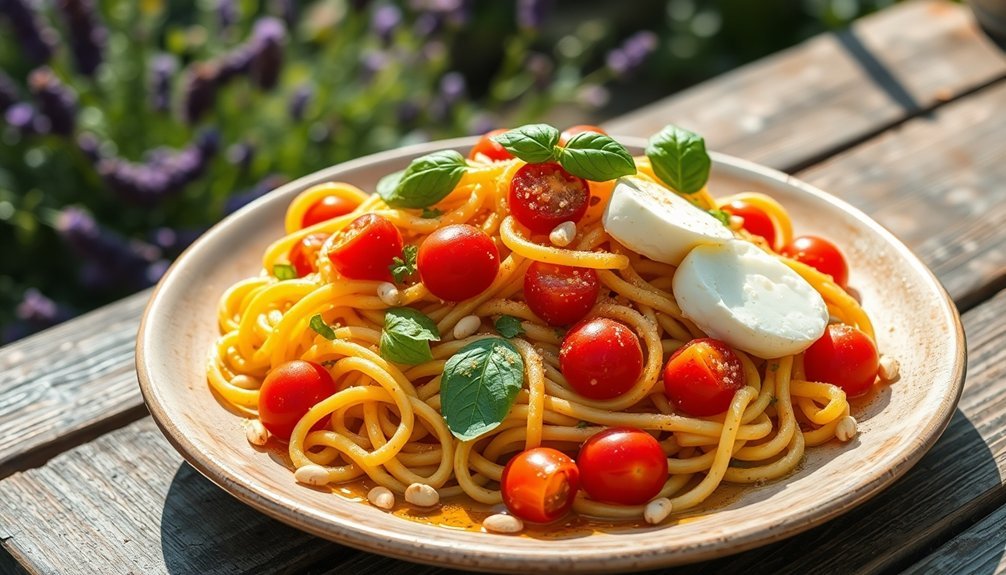
While summer gardens burst with fresh produce, Summer Garden Solar Fusilli captures the season's bounty in a light, flavorful pasta dish that harnesses the sun's natural warmth. You'll need fresh grape or heirloom tomatoes, fragrant basil leaves, quality extra-virgin olive oil, and minced garlic as your base ingredients.
To create this sun-kissed dish, you'll start by combining halved tomatoes, garlic, and olive oil in a bowl, letting the mixture marinate in direct sunlight for at least four hours. This natural process releases the tomatoes' juices and intensifies their flavors.
While the mixture marinates, cook your fusilli until it's perfectly al dente. Once your pasta's ready, toss it with the sun-marinated tomato mixture and add grated Parmigiano-Reggiano.
You can enhance your dish with optional ingredients like Kalamata olives, feta cheese, or additional summer vegetables such as zucchini or bell peppers. Season with salt, black pepper, and red pepper flakes to taste, then garnish with fresh basil leaves.
If you're cooking outdoors, consider using a solar oven to prepare both the pasta and sauce, adjusting cooking times based on your specific solar cooker and temperature conditions.
Protein-Rich Solar Cooking Pasta
You'll love these protein-packed solar pasta options that make the most of natural sunlight cooking methods.
Whether you choose the solar-cooked chicken penne with its rich cream sauce, the quick sun-dried tomato protein pasta with whipped ricotta, or the vegan pea pesto power blend, each dish delivers impressive protein content while using sustainable cooking techniques.
These nutrient-dense recipes work perfectly in your solar oven, letting you create satisfying meals while harnessing the sun's energy.
Solar-Cooked Chicken Penne
Cooking up a delicious chicken penne dish using solar power combines sustainable energy with protein-packed comfort food. You'll need penne pasta, diced chicken seasoned with salt, pepper, and garlic powder, plus a flavorful tomato sauce mixture. The key to success lies in proper preparation and monitoring of your solar oven's temperature, which should reach about 200°F for ideal results.
Start by breaking the pasta to fit your solar-safe pot and letting it absorb some water to prevent clumping. Then, combine it with your seasoned chicken and sauce mixture, ensuring all pasta is well-covered. Your solar cooking time will range from 1-2 hours, depending on cloud cover and temperature maintenance.
For the best solar-cooked chicken penne experience:
- Pre-heat your solar oven before adding ingredients, and stir occasionally during cooking to maintain even heat distribution.
- Monitor weather conditions and adjust cooking time accordingly – cloudy days will require longer cooking periods.
- Add fresh Parmesan cheese just before serving, and consider complementing your dish with solar-baked breadsticks.
You can customize this versatile dish by substituting chicken with other proteins or adding pre-cooked meatballs for variety.
Quick Sun-Dried Tomato Protein
Ready to transform sun-dried tomatoes into a protein-packed pasta dish? You'll start by cooking 8-10 ounces of penne pasta until al dente, making sure to reserve some pasta water for the sauce. While the pasta cooks, heat olive oil in a large skillet and sauté minced garlic with red pepper flakes and chopped sun-dried tomatoes until fragrant.
For protein options, you've got versatile choices that work perfectly with the sun-dried tomato base:
| Protein Source | Preparation | Flavor Profile |
|---|---|---|
| Chickpeas | Stir into sauce | Nutty, hearty |
| Cashew Cream | Blend with tomato paste | Rich, creamy |
| Parmesan | Grate and fold in | Sharp, salty |
Combine your chosen protein with the pasta and sun-dried tomato mixture, adding reserved pasta water to create a silky sauce. For extra nutrition, fold in fresh arugula or spinach. While this dish isn't traditionally solar-cooked, you can adapt it by using a solar oven – just increase the water content and monitor internal temperature carefully. Remember to season with kosher salt and black pepper to taste.
Vegan Pea Pesto Power
Bursting with plant-based protein, this vegan pea pesto pasta transforms traditional basil pesto into a nutrient-rich powerhouse.
You'll combine protein-packed cashews and peas with fresh basil, vegan parmesan, and zesty lemon for a creamy, flavorful sauce that's perfect for your solar cooking adventure.
To adapt this dish for solar cooking, you'll need to make a few strategic adjustments. Start by soaking your cashews in boiling water, and while they soften, prepare your solar oven for pasta cooking. You'll want to reserve plenty of pasta water to achieve the ideal sauce consistency.
- Blend your soaked cashews with peas, basil, garlic, olive oil, and seasonings until you've got a smooth, vibrant paste.
- Cook your pasta in the solar oven, monitoring carefully to reach the perfect al dente texture.
- Combine your pasta with the pesto sauce, adding reserved pasta water until you achieve your desired consistency.
While traditional pesto pasta recipes aren't specifically designed for solar cooking, you can successfully prepare this dish by adjusting your cooking times and closely monitoring your solar oven's temperature.
The result is a protein-rich, sustainable meal that's both satisfying and environmentally conscious.
Quick Solar Pasta Alfredo
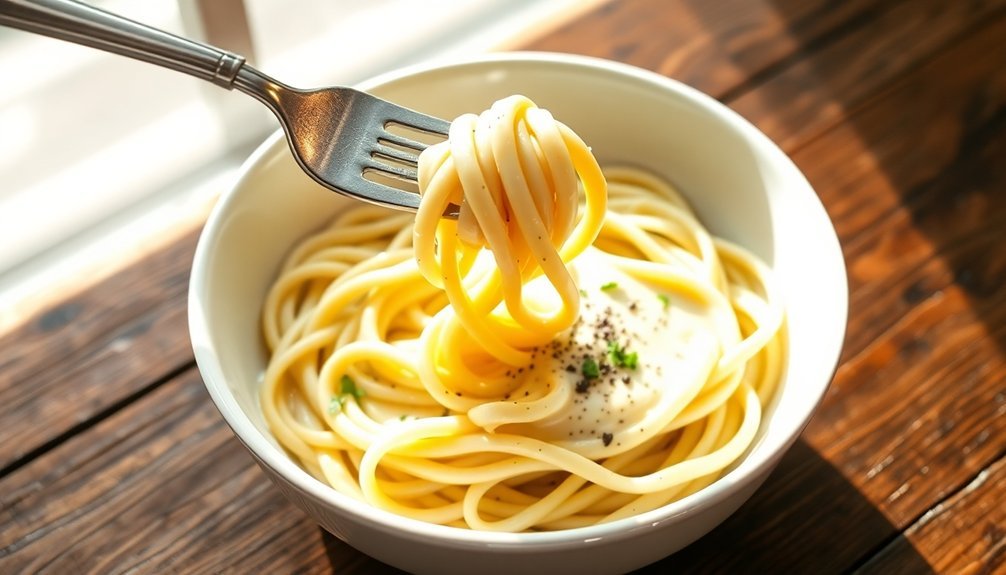
In accordance with solar cooking principles, this streamlined Pasta Alfredo recipe transforms a classic Italian dish into a solar-powered delight.
You'll need fettuccine pasta, heavy cream, unsalted butter, Parmesan cheese, and basic seasonings to create this creamy comfort food in your solar oven.
To maximize efficiency, you'll want to use the one-pot method by combining all ingredients in a solar-safe pot. Start by letting the pasta absorb water until it's nearly al dente.
Then, add your cream, butter, and cheese mixture, making sure to cover the pot for even heat distribution. You'll need to maintain an internal temperature of around 190°F, which typically takes 1-2 hours in a solar oven.
If you find your sauce is too thick, you can adjust the consistency using reserved pasta water. Don't forget to gently separate the pasta strands while cooking to prevent clumping.
For added variety, you can incorporate sun-dried tomatoes, mushrooms, or broccoli into your sauce. When serving, top with extra grated Parmesan and pair with solar-baked breadsticks for a complete meal.
Solar Cooked Gluten-Free Pasta Options
Gluten-free pasta dishes adapt beautifully to solar cooking, offering three versatile base options: rice, corn, or quinoa-based noodles. You'll want to start by selecting your preferred pasta type and ensuring it's completely submerged in liquid before placing it in your solar oven. For the best results, let the pasta absorb some water before adding your chosen sauce and ingredients.
To create delicious gluten-free solar pasta dishes, follow these key steps:
- Begin with a marinara or cream-based sauce, adding enough liquid to prevent the pasta from becoming too dry during cooking.
- Include pre-cooked proteins like meatballs or crumbled sausage, plus vegetables such as broccoli or mushrooms.
- Season generously with garlic powder, basil, and oregano for authentic Italian flavor.
You can enhance your dish by incorporating sundried tomatoes, portabella mushrooms, or a dairy-free alternative like coconut milk for creaminess.
The cooking process typically takes about an hour in your solar oven. Remember to stir occasionally to prevent clumping, and adjust the liquid ratio based on your specific pasta type. Finish with fresh herbs and your choice of cheese or dairy-free alternative.
Herb-Infused Solar Pasta Dishes
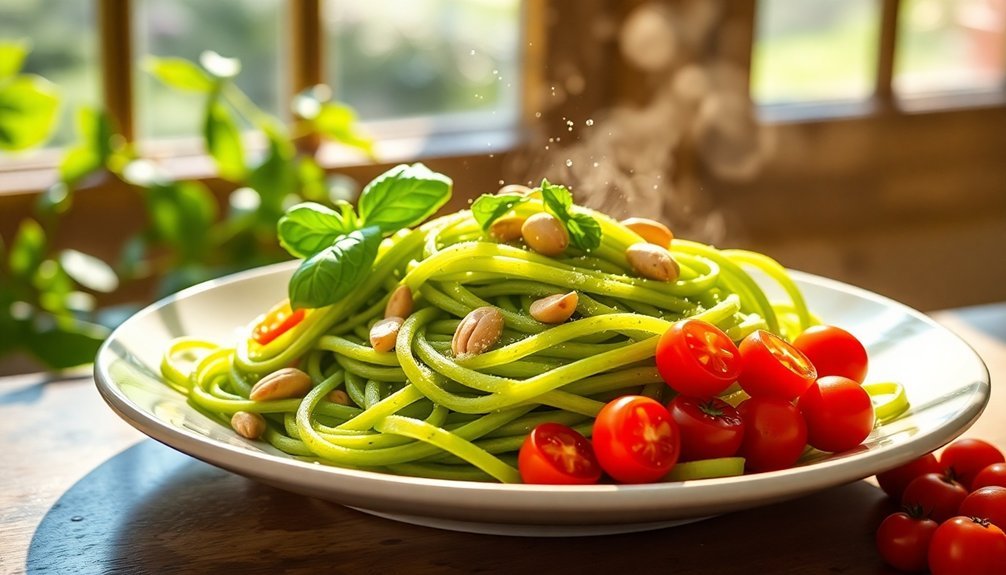
Fresh herbs transform solar-cooked pasta into aromatic, flavorful masterpieces that maximize your solar cooking experience.
You'll need long pasta varieties like penne, spaghetti, or fettuccine, combined with fresh or dried herbs such as basil, parsley, and oregano. Don't forget to include minced garlic and high-quality extra virgin olive oil for the base flavors.
Start by cooking your pasta al dente and reserving some pasta water. Heat olive oil or butter in a skillet, then add your chosen herbs and garlic. Toss the cooked pasta in this fragrant mixture until it's evenly coated.
You can enhance your dish with proteins like tuna or chicken, or add vegetables such as mushrooms and cherry tomatoes for extra nutrition and texture.
For the best results, adjust seasoning to taste and finish with freshly grated Parmesan cheese.
You'll want to store any leftovers in an airtight container for up to three days. When reheating, add a splash of reserved pasta water to maintain the proper consistency.
For a different twist, try baking your herb-infused pasta at 350°F for 20-25 minutes in a covered dish.
Solar Cooker Pasta Storage Tips
Properly storing solar-cooked pasta requires careful attention to both containers and environmental conditions. You'll need food-grade containers with gasket lids to maintain an airtight environment, protecting your pasta from moisture and contamination.
For ideal storage, combine wide-mouth glass jars or food-grade buckets with mylar bags to create multiple barriers against environmental factors.
To maximize your pasta's shelf life, implement these essential oxygen control methods:
- Place oxygen absorbers inside your storage containers to remove air and prevent spoilage.
- Use a vacuum sealer or brake bleeder to extract air from jars before sealing.
- Add dried bay laurel leaves to naturally deter pests and maintain freshness.
You'll want to keep your stored pasta in a cool, dry location away from direct sunlight and heat sources. Regular inspection of your storage area helps identify potential pest problems early.
Don't forget to clean your containers thoroughly before use, removing any dust or residue that could compromise your pasta's quality. If you're using mylar bags, verify they're properly sealed to maintain the effectiveness of your oxygen absorbers and pest protection measures.
Frequently Asked Questions
Can I Cook Pasta in Cloudy Weather Using a Solar Cooker?
You can cook pasta in cloudy weather with a solar cooker, but it's not ideal. You'll face longer cooking times and may get inconsistent results. It's best to choose sunny days for solar pasta cooking.
What's the Best Time of Day to Start Solar Cooking Pasta?
You'll want to start cooking your pasta between 10 AM and noon. This gives you ideal sunlight and enough time to complete the cooking process before the sun's intensity decreases after 4 PM.
How Do I Prevent Pasta From Getting Mushy in a Solar Cooker?
You'll prevent mushy pasta by using sturdy shapes like penne, controlling liquid levels, and adding pasta in the final hour of cooking. Don't overcrowd the pot, and choose ridged pasta that holds its shape.
Which Solar Cooker Types Work Best for Different Pasta Shapes?
You'll get best results using parabolic cookers for short pasta like penne, solar flares for spiral shapes, and solar ovens for long pasta like spaghetti. Each cooker's heat distribution matches specific pasta shapes.
Does Altitude Affect Solar Pasta Cooking Times and Temperatures?
Yes, altitude will affect your solar pasta cooking. You'll need longer cooking times since water boils at lower temperatures in high elevations. Plan to add extra water and monitor your pasta more carefully for proper doneness.
In Summary
You've got plenty of delicious solar-cooking options to transform ordinary pasta into sun-powered meals. Whether you're craving classic sun-dried tomato pasta or want to experiment with Mediterranean flavors, these dishes make the most of natural energy while delivering amazing taste. Remember to store your solar-cooked pasta properly and don't hesitate to try gluten-free alternatives. You'll love how the sun brings out the best in every recipe.

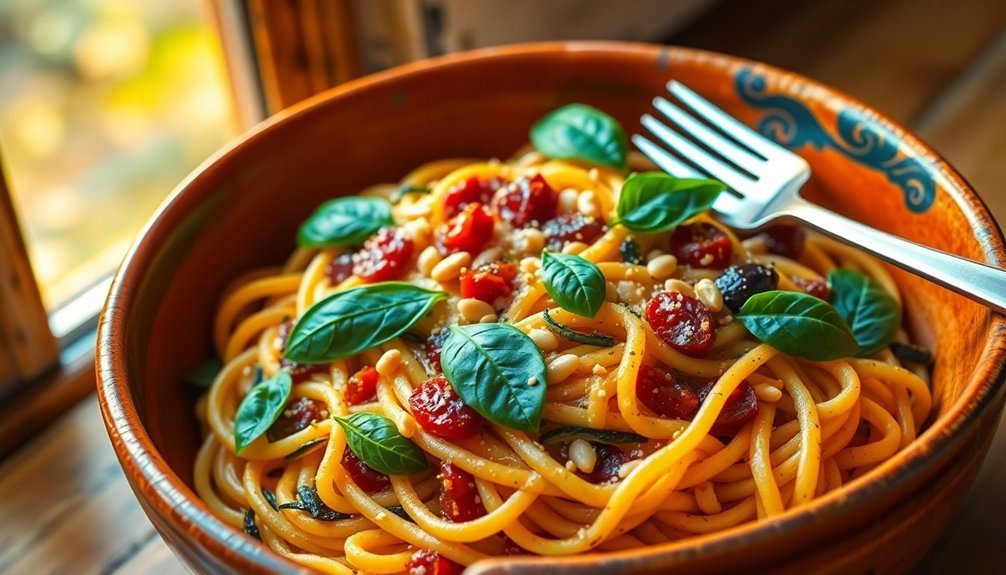



Leave a Reply